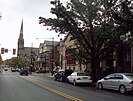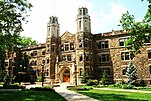
A | B | C | D | E | F | G | H | CH | I | J | K | L | M | N | O | P | Q | R | S | T | U | V | W | X | Y | Z | 0 | 1 | 2 | 3 | 4 | 5 | 6 | 7 | 8 | 9
Bethlehem, Pennsylvania | |
|---|---|
Northside Bethlehem as viewed from the Hill to Hill Bridge | |
| Nicknames: Christmas City[1] and Steel City | |
 Interactive map of Bethlehem | |
| Coordinates: 40°37′34″N 75°22′32″W / 40.62611°N 75.37556°W | |
| Country | United States |
| State | Pennsylvania |
| County | Lehigh and Northampton |
| Founded | December 24, 1741 |
| Government | |
| • Type | Mayor–council |
| • Mayor | J. William Reynolds (D)[2] |
| Area | |
| • City | 19.46 sq mi (50.40 km2) |
| • Land | 19.11 sq mi (49.51 km2) |
| • Water | 0.34 sq mi (0.89 km2) |
| • Urban | 289.50 sq mi (749.79 km2) |
| • Metro | 730.0 sq mi (1,174.82 km2) |
| Elevation | 360 ft (109.728 m) |
| Population | |
| • City | 75,781 |
| • Rank | 2nd in the Lehigh Valley 8th in Pennsylvania |
| • Density | 3,964.48/sq mi (1,530.67/km2) |
| • Metro | 865,310 (US: 68th) |
| Time zone | UTC−05:00 (EST) |
| • Summer (DST) | UTC−04:00 (EDT) |
| ZIP Codes | 18015, 18016, 18017, 18018, and 18019 |
| Area codes | 610 and 484 |
| FIPS code | 42-06088 |
| Primary airport | Lehigh Valley International Airport |
| Major hospital | Lehigh Valley Hospital–Cedar Crest |
| School district | Bethlehem Area |
| Website | www |
Bethlehem is a city in Northampton and Lehigh Counties in the Lehigh Valley region of eastern Pennsylvania, United States. [5]As of the 2020 census, Bethlehem had a total population of 75,781, making it the second-largest city in the Lehigh Valley after Allentown and the seventh-largest city in the state.[6] Among its total population as of 2020, 55,639 were in Northampton County and 19,343 were in Lehigh County. The city is located along the Lehigh River, a 109-mile-long (175 km) tributary of the Delaware River.
Bethlehem lies in the geographic center of the Lehigh Valley, a metropolitan region of 731 sq mi (1,890 km2) with a population of 861,899 people as of the 2020 census that is Pennsylvania's third-most populous metropolitan area and the 68th-most populated metropolitan area in the U.S. Bethlehem borders Allentown to its west and is 48 miles (77 km) north of Philadelphia and 72 miles (116 km) west of New York City.
There are four sections to the city: central Bethlehem, the south side, the east side, and the west side. Each of these sections blossomed at different times in the city's development and each contains areas recognized under the National Register of Historic Places. Norfolk Southern Railway's Lehigh Line, formerly the main line of the Lehigh Valley Railroad, runs through Bethlehem heading east to Easton and across the Delaware River to Phillipsburg, New Jersey. The Norfolk Southern Railway's Reading Line runs through Bethlehem and west to Allentown and Reading.
Bethlehem has a long historical relationship with the celebration of Christmas. The city was christened as Bethlehem on Christmas Eve 1741 by Nicolaus Zinzendorf, a Moravian bishop. In 1747, Bethlehem was the first U.S. city to feature a decorated Christmas tree.[7] On December 7, 1937, at a grand ceremony during the Great Depression, the city adopted the nickname Christmas City USA in a large ceremony.[8] It is one of several Lehigh Valley locations, including Egypt, Emmaus, Jordan Creek, and Nazareth, whose names were inspired by locations in the Bible.[9]
History
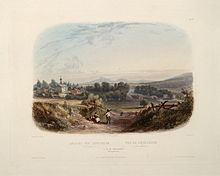

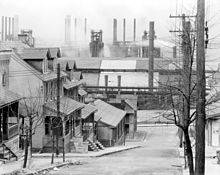

Settlement
Prior to European settlements, the areas around present-day Bethlehem and its surrounding locales along the Delaware River and its tributaries in eastern Pennsylvania were inhabited by various indigenous peoples, including the Algonquian-speaking Lenape, which had three main divisions, known by the dialects, the Unami, Unalachtigo, and Munsee. They traded with the Dutch and then British colonialists in the Mid-Atlantic region in present-day Connecticut, Delaware, Long Island, Maryland, New Jersey, and the lower Hudson Valley in New York, and other regions in Pennsylvania.
18th century
On April 2, 1741, William Allen, a wealthy Philadelphia merchant and political figure, who later founded the city of Allentown, deeded 500 acres (200 ha) along the banks of the Monocacy Creek and Lehigh River to the Moravian Church.[10] On Christmas Eve of that year, David Nitschmann and Nicolaus Zinzendorf, leading a small group of Moravians, founded the mission community of Bethlehem at the confluence of the Monocacy and Lehigh rivers. They established missionary communities among the Native Americans and unchurched German-speaking Christians and named the settlement after the Biblical town Bethlehem of Judea, said to be the birthplace of Jesus. "Count Zinzendorf said, 'Brothers, how more fittingly could we call our new home than to name it in honor of the spot where the event we now commemorate took place. We will call this place Bethlehem.' And so was Bethlehem named after the birthplace of the Man of Peace."
Bethlehem was started as a typical Moravian Settlement Congregation, where the Church owned all the property. Until the 1850s, officially only members of the Moravian Church were permitted to lease land plots in Bethlehem. But a member of a group of families who were Huguenots also settled in Bethlehem. In the late 1700s, Bethlehem established grist and saw mills, known as Calvin's Mills.[11] The historic Brethren's House, Sisters' House, Widows' House, and Gemeinhaus (Congregation House), with the Old Chapel, are remnants of this period of communal living.[12]
The Moravians ministered to the regional Lenape Native Americans through their mission in the area, and to others further east in the New York colony. In historic Bethlehem's God's Acre cemetery, converted Lenape were buried alongside Moravians. In 1762, Bethlehem built the first waterworks in America to pump water for public use.
In the autumn of 1777, during the American Revolutionary War, many patriots fled from Philadelphia to Bethlehem and the surrounding area as the British Army advanced from the east. The Marquis de Lafayette recovered from an injury received at the Battle of Brandywine in Bethlehem, and several of the most prominent members of the Continental Congress fled north to Bethlehem before the congress eventually reconvened in Lancaster. Before, during, and after the American Revolution, Bethlehem was visited by George Washington and his wife Martha, Alexander Hamilton, Benjamin Franklin, John Adams, Samuel Adams, John Hancock, and the Marquis de Lafayette. On September 22, 1777, fourteen members of the Second Continental Congress signed the Moravian Sun Inn register in Bethlehem and stayed there overnight.[13][14]
George Washington stored his personal effects at the James Burnside farm at 1461 Schoenersville Road in Bethlehem. as of 1998[update], this site is operated as a historical museum known as James Burnside Plantation.[15]
19th century

In 1845, Bethlehem was a prosperous village that was incorporated into a free borough in the County of Northampton. After the Unity Synod of 1848, Bethlehem became the headquarters of the Northern Province of the Moravian Church in North America.[16] On March 27, 1900, the Bach Choir of Bethlehem presented the United States debut of German Lutheran composer Johann Sebastian Bach's Mass in B Minor in the city's Central Moravian Church. Bethlehem was one of the four leading Moravian communities in the Northeastern United States; Emmaus, Lititz, and Nazareth, each in Pennsylvania, were the three others.
In 1865, after the end of the Civil War, the Borough of South Bethlehem was formed. In 1886, the Borough of West Bethlehem in Lehigh County was formed.
20th century
In 1901, the Borough of Northampton Heights was incorporated. Starting in 1904, the borough of Bethlehem began a concerted effort to merge with its neighboring municipalities. In 1904 Bethlehem absorbed West Bethlehem followed shortly after in 1905 by Hottlesville. South Bethlehem would attempt to resist merger and incorporated themselves as their own city in 1913, however, the Supreme Court of Pennsylvania struck down their incorporation as unconstitutional in 1915 and in 1917 South Bethlehem would be annexed.
Following the merger with South Bethlehem, the new consolidated City of Bethlehem was incorporated. Bethlehem Steel executive Archibald Johnston was elected the new city's first mayor. Northampton Heights was incorporated into the city in 1920 after significant local resistance and a failed proposed merger between Northampton Heights and Hellertown to make a rival city. With the annexation of Hottlesville, Macada, Altonah, and Shimersville, Bethlehem's present borders were established.
Geography

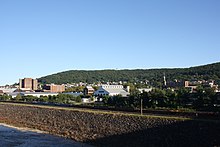

According to the U.S. Census Bureau, the city has a total area of 19.4 square miles (50 km2), of which 19.3 square miles (50 km2) is land and 0.2 square miles (0.52 km2) (0.88%) is water. Because large volumes of water were required in the steelmaking process, the city purchased 22,000 acres (8,900 ha) of land in the Pocono Mountains, where its water is stored in reservoirs. The Lehigh River, a tributary of the Delaware, flows through Bethlehem. Monocacy and Saucon Creeks empty into the Lehigh River in Bethlehem.
Bethlehem is approximately 50 miles (80 km) north of Philadelphia and about 80 miles (130 km) west of New York City.
Climate
Bethlehem has a humid continental climate (Dfa). Summers are typically hot and humid, fall and spring are generally mild, and winter is cold. Precipitation is distributed fairly uniformly throughout the year, with thunderstorms in the summer, showers in spring and fall, and snow in winter. The average high temperature varies widely, from 37 °F (3 °C) in January to 85 °F (29 °C) in July. The highest recorded temperature was 105 °F (41 °C), while the lowest recorded temperature was −16 °F (−27 °C).
Bethlehem falls under the USDA 6b Plant hardiness zone.[17]
| Climate data for Bethlehem | |||||||||||||
|---|---|---|---|---|---|---|---|---|---|---|---|---|---|
| Month | Jan | Feb | Mar | Apr | May | Jun | Jul | Aug | Sep | Oct | Nov | Dec | Year |
| Record high °F (°C) | 72 (22) |
76 (24) |
87 (31) |
94 (34) |
97 (36) |
100 (38) |
105 (41) |
105 (41) |
99 (37) |
93 (34) |
81 (27) |
72 (22) |
105 (41) |
| Mean daily maximum °F (°C) | 37 (3) |
40 (4) |
49 (9) |
61 (16) |
72 (22) |
80 (27) |
85 (29) |
82 (28) |
75 (24) |
64 (18) |
53 (12) |
41 (5) |
62 (16) |
| Mean daily minimum °F (°C) | 21 (−6) |
22 (−6) |
29 (−2) |
39 (4) |
48 (9) |
58 (14) |
64 (18) |
61 (16) |
53 (12) |
41 (5) |
33 (1) |
24 (−4) |
41 (5) |
| Record low °F (°C) | −16 (−27) |
−12 (−24) |
−5 (−21) |
12 (−11) |
29 (−2) |
39 (4) |
38 (3) |
41 (5) |
31 (−1) |
19 (−7) |
3 (−16) |
−9 (−23) |
−16 (−27) |
| Average precipitation inches (mm) | 3.03 (77) |
2.80 (71) |
3.39 (86) |
3.56 (90) |
4.14 (105) |
4.31 (109) |
4.95 (126) |
3.69 (94) |
4.62 (117) |
3.88 (99) |
3.50 (89) |
3.58 (91) |
45.45 (1,154) |
| Source: The Weather Channel[18] | |||||||||||||
Neighborhoods
Bethlehem is divided into five main areas: Center City, West Side, East Side, South Side, and North Side. The West Side is located in Lehigh County and the other four neighborhoods are in Northampton County.
- Center City is bounded by Monocacy Creek to the west, Dewberry Ave. to the North, and Stefko Boulevard to the east.
- The West Side begins at the city's western border with Allentown and continues east to the Monocacy Creek and north to Hanover Township.
- The Mount Airy Neighborhood is bounded by Pennsylvania Ave to the west, West Broad St to the north, 2nd Avenue to the east, and the Lehigh River to the south.
- The East Side is bordered to the west by Center City and to the east by Bethlehem Township and Freemansburg. The East Side includes the Pembroke Village area.
- The South Side's borders are Fountain Hill to the west, the Lehigh River to the north, South Mountain to the south, and Hellertown to the east.
- The North Side begins above Dewberry Ave and extends up Route 191 (Linden Ave) to Oakland Road, where the city and township divide is. Northside extends as far West as Monocacy Creek on Macada Road and as far East as Easton Ave and Stefko Blvd. intersection. 'North Side' refers more to a cultural division than an actual boundary.
Demographics
| Census | Pop. | Note | %± |
|---|---|---|---|
| 1850 | 1,516 | — | |
| 1860 | 2,866 | 89.1% | |
| 1870 | 4,512 | 57.4% | |
| 1880 | 5,193 | 15.1% | |
| 1890 | 6,762 | 30.2% | |
| 1900 | 7,293 | 7.9% | |
| 1910 | 12,837 | 76.0% | |
| 1920 | 50,358 | 292.3% | |
| 1930 | 57,892 | 15.0% | |
| 1940 | 58,490 | 1.0% | |
| 1950 | 66,340 | 13.4% | |
| 1960 | 75,408 | 13.7% | |
| 1970 | 72,686 | −3.6% | |
| 1980 | 70,419 | −3.1% | |
| 1990 | 71,428 | 1.4% | |
| 2000 | 71,329 | −0.1% | |
| 2010 | 74,982 | 5.1% | |
| 2020 | 75,781 | 1.1% | |
| Sources:[19][20][21][22][4] | |||
As of the 2020 census,[20] there are 75,781 people living in the city. The racial makeup of the city is 72.7% White, 9.2% African American, 0.3% Native American, 0.0% Pacific Islander, 3.1% Asian American, 9.8% from other races, and 7.5% from two or more races. Hispanic or Latino of any race are 29.9% of the population.
As of the census[20] of 2010, there were 74,982 people living in the city. There were 31,221 housing units, with 5.9% vacant. The racial makeup of the city was 76.4% White, 6.9% African American, 0.3% Native American, 2.9% Asian, 0.0% Pacific Islander, 10.0% from other races, and 3.4% from two or more races. Hispanic or Latino of any race were 24.4% of the population.
As of the census[20] of 2000, there were 71,329 people living in the city, including 17,094 families and 28,116 households. The population density was 3,704.4 inhabitants per square mile (1,430.3/km2). There were 29,631 housing units at an average density of 1,538.8 per square mile (594.1/km2). The racial makeup of the city was 81.85% White, 3.64% African American, 0.26% Native American, 2.22% Asian, 0.03% Pacific Islander, 9.44% from other races, and 2.56% from two or more races. Hispanic or Latino of any race were 18.23% of the population. There were 28,116 households, out of which 26.3% had children under the age of 18 living with them, 44.1% were married couples living together, 12.8% had a female householder with no husband present, and 39.2% were non-families. 32.3% of all households were made up of individuals, and 14.4% had someone living alone who was 65 years of age or older. The average household size was 2.34 and the average family size was 2.95.
In the city, the population was spread out, with 21.0% under the age of 18, 14.4% from 18 to 24, 26.6% from 25 to 44, 20.1% from 45 to 64, and 17.9% who were 65 years of age or older. The median age was 36 years. For every 100 females, there were 91.5 males. For every 100 females age 18 and over, there were 88.6 males. The median income for a household in the city was $35,815, and the median income for a family was $45,354. Males had a median income of $35,190 versus $25,817 for females. The per capita income for the city was $18,987. About 11.1% of families and 15.0% of the population were below the poverty line, including 20.7% of those under age 18 and 8.8% of those age 65 or over.
Crime
| Bethlehem | |
|---|---|
| Crime rates* (2018) | |
| Violent crimes | |
| Homicide | 1.3 |
| Rape | 42.2 |
| Robbery | 65.9 |
| Aggravated assault | 163.6 |
| Total violent crime | 273.0 |
| Property crimes | |
| Burglary | 286.2 |
| Larceny-theft | 1,329.7 |
| Motor vehicle theft | 73.9 |
| Arson | 6.6 |
| Total property crime | 1689.8 |
Notes *Number of reported crimes per 100,000 population. 2018 population: 75,809 Source: 2018 FBI UCR Data | |
In the Lehigh Valley, Bethlehem had a lower crime rate as of 2018 than Allentown, but a higher crime rate than Easton, the Lehigh Valley's third-largest city. In 2018, Bethlehem had a violent crime index of 273.0, while Allentown's violent crime index was 338.4 and Easton's was 254.1.[23] For reference, the United States' average was 368.9 in 2018.[24]
Economy
Bethlehem Steel
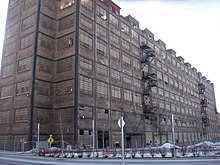
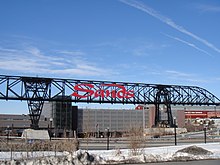
Bethlehem became a center of heavy industry and trade during the industrial revolution. Bethlehem Steel (1857–2003), founded and based in Bethlehem, was once the second-largest steel producer in the United States, after Pittsburgh-based U.S. Steel. The company was a powerhouse in the mid-twentieth century, with over 30,000 employees at its peak.[25] Bethlehem Steel was also one of the largest shipbuilding companies in the world and one of the most powerful symbols of American industrial manufacturing leadership, and it manufactured over 1,100 warships used in World War II.
Bethlehem Steel began producing the first wide-flange structural shapes made in the United States and they pioneered the production of the now-ubiquitous "I-beam" used in construction of steel-framed buildings, including skyscrapers. It manufactured construction materials for numerous New York City and other city skyscrapers and major bridges.
The company became a major supplier of armor plate and ordnance products during World War I and World War II. After roughly 140 years of metal production at its Bethlehem plant, Bethlehem Steel ceased operations there in 1995, in the face of overseas competition and declining demand, and the company's liquidation was completed in 2003.
Wind Creek Bethlehem
In December 2006, Las Vegas Sands Corp was awarded a Category 2 Slot Machine License by the Pennsylvania Gaming Control Board. LVSC began work on the site, categorized as both the largest brownfield redevelopment project in the nation and the largest casino development investment made to date in Pennsylvania. [26]Its mission was to create reinvestment and urbanization in the area. At a projected cost of $743 million, the historic Bethlehem Steel plant is being redeveloped as a fully integrated resort, to include 3,000 slot machines, over 300 hotel rooms, 9 restaurants, 200,000 square feet (19,000 m2) of retail outlet shopping, and 46,000 square feet (4,300 m2) of flexible multi-purpose space.[27] In 2007, the casino resort company of Las Vegas Sands began the construction of Sands Casino Resort Bethlehem, later rebranded as Wind Creek Bethlehem. The casino has been projected to bring in approximately one million dollars in revenue per day as of 2009.
Another major economic anchor to the city is St. Luke's Hospital located in neighboring Fountain Hill. That Hospital and Health Network is the second-largest of its type in the Lehigh Valley. Other major employers include B. Braun, Lehigh University, and the Guardian Life Insurance Company of America.[28]
Other companies in Bethlehem include the candy company Just Born. Zulily has a large logistics operation in the city that serves the United States.[29]
Retail development
Zdroj:https://en.wikipedia.org?pojem=Bethlehem,_PennsylvaniaText je dostupný za podmienok Creative Commons Attribution/Share-Alike License 3.0 Unported; prípadne za ďalších podmienok. Podrobnejšie informácie nájdete na stránke Podmienky použitia.
Antropológia
Aplikované vedy
Bibliometria
Dejiny vedy
Encyklopédie
Filozofia vedy
Forenzné vedy
Humanitné vedy
Knižničná veda
Kryogenika
Kryptológia
Kulturológia
Literárna veda
Medzidisciplinárne oblasti
Metódy kvantitatívnej analýzy
Metavedy
Metodika
Text je dostupný za podmienok Creative
Commons Attribution/Share-Alike License 3.0 Unported; prípadne za ďalších
podmienok.
Podrobnejšie informácie nájdete na stránke Podmienky
použitia.
www.astronomia.sk | www.biologia.sk | www.botanika.sk | www.dejiny.sk | www.economy.sk | www.elektrotechnika.sk | www.estetika.sk | www.farmakologia.sk | www.filozofia.sk | Fyzika | www.futurologia.sk | www.genetika.sk | www.chemia.sk | www.lingvistika.sk | www.politologia.sk | www.psychologia.sk | www.sexuologia.sk | www.sociologia.sk | www.veda.sk I www.zoologia.sk


